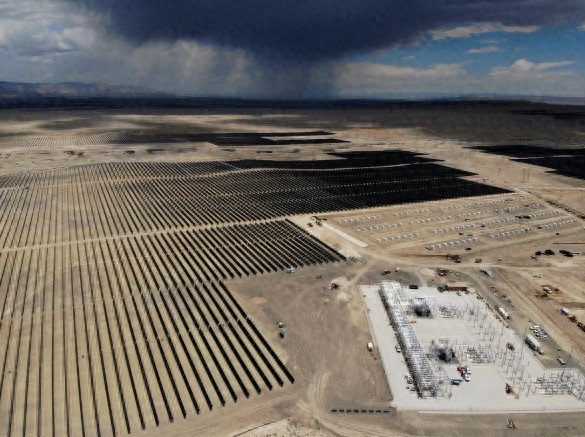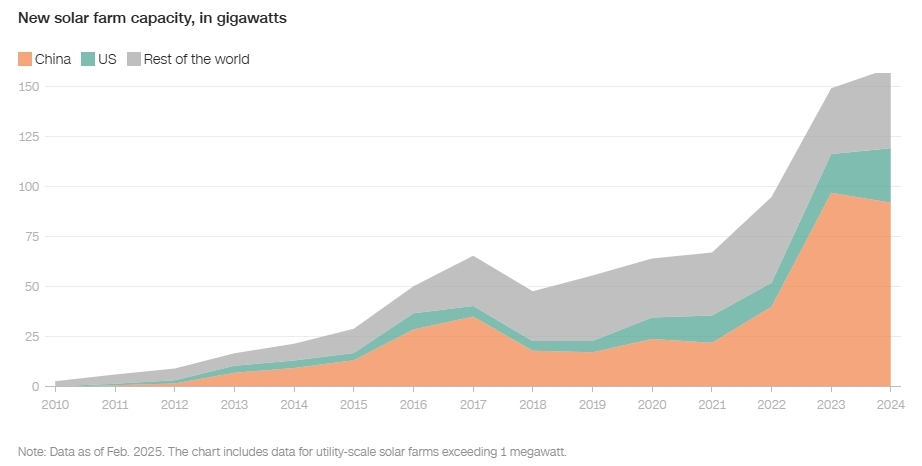【By Observer Net, Qi Qian】"China's new wind and solar power generation capacity added within a year exceeds the total of all renewable energy in the United States."
On July 16, the U.S. cable news network CNN published an article stating that this incredible data can be used to summarize the current new clean energy landscape, which means the United States has completely lost to China in this field. The report also cited analysis stating that the finalization of the "Big and Beautiful" tax and spending bill means that the Trump administration has personally ended the fate of the U.S. clean energy industry.

Solar power plant under construction in Emery City, Utah, U.S. media
Data from Global Energy Monitor shows that the United States is far behind China in the competition for the clean energy industry.
Earlier this month, President Trump signed the "Big and Beautiful" Act, marking the controversial legislation as law. Experts told CNN that the act significantly cuts back on clean energy tax incentives, which will solidify the United States' lagging position in the clean energy sector.
Business leaders in the United States warned that with the rising costs of building the cheapest grid energy (wind and solar power) and being replaced by more expensive natural gas, American businesses and consumers will face higher electricity prices. More seriously, as the clean energy industry prepares to break through into high-efficiency technologies and battery storage, the withdrawal of funding will cause the industry to stagnate.
According to data from Global Energy Monitor, China is currently building 51 gigawatts of utility-scale solar and wind power capacity, plus 1,400 gigawatts already connected to the grid (five times the total of the United States), forming a crushing advantage over the United States.
"In short, the result of the game is no longer in doubt," said Li Shuo, director of the Center for Chinese Climate at the Asia Society Policy Institute.

China's total wind and solar power generation capacity far exceeds that of the United States, leading globally. CNN map
According to reports, wind and solar power are also becoming a dominant force in the United States, supported by giant batteries that can store energy, but on a much smaller scale than China. In recent years, most of the new power added in the United States has come from renewable energy, accounting for about 85% of the current approved license queue. According to the U.S. Energy Information Administration, as of the end of last year, the United States had about 27.5 gigawatts of wind and solar power in operation.
Data shows that by 2031, the United States plans to build another 15 gigawatts of wind and solar projects, but these projects face risks due to the Trump administration's cancellation of renewable energy subsidies. According to models constructed by the U.S. think tank Rhodium Group, the "Big and Beautiful" Act will cut in half the amount of additional renewable energy capacity expected to be connected to the grid over the next decade. The report states that this will lead to higher electricity prices in U.S. states.
In contrast, China's wind and solar power installation speed is astonishing, with 510 gigawatts of ongoing installations. Li Shuo said that this number seems slightly higher than the predictions of Chinese analysts. Analysts from Global Energy Monitor told CNN that there are policy-driven factors behind this.

China's new solar power generation capacity (orange) is three times that of the United States (green). CNN map
Most of China's wind and solar power plants are far away from its big cities. But in Beijing, the energy transition manifests in another way. Li Shuo said that in Beijing, the number of fuel-powered cars on the road is not high, and most ride-hailing drivers drive electric vehicles.
"All drivers will tell you that buying a fuel-powered car makes no economic sense for them," Li Shuo said, "some drivers told me that the fuel cost of electric vehicles is about one-sixth of that of fuel-powered cars."
Li Shuo said that some analysts believe that with the popularity of electric vehicles, China's oil consumption has reached a peak. In recent months, all the increased power demand in China has been met by renewable energy, meaning that despite the increase in electricity consumption, greenhouse gas pollution has not increased.
But in the United States, higher electricity prices could severely hinder economic development and prevent companies from setting up factories in the U.S., which contradicts Trump's priority of promoting manufacturing back to the U.S. Due to the reduction in wind and solar power additions caused by the "Big and Beautiful" Act, and the slow approval of new natural gas power plants, industries such as data centers and semiconductor manufacturing may face power shortages.
Rhodium Group analyst Ben King warned, "Data centers, semiconductor manufacturing, and other new industrial loads may not be able to go online because we may not have enough generating capacity to meet the demand."
The passage of the "Big and Beautiful" tax and spending bill also means that Republicans successfully cut off billions of dollars in federal clean energy subsidies, and clean energy tax incentives will be gradually phased out by 2027. On July 4, the Washington Post published an article stating that Republicans' move unexpectedly created a winner: the Chinese artificial intelligence (AI) industry.
The article pointed out that while China is investing heavily to enhance its energy capacity to support its ambition to lead in the AI field, U.S. tech companies are struggling to obtain sufficient power to maintain the high-energy operations of their AI data centers.
At the time, an American clean energy developer said that the current dominance in AI depends on who has the most power, and the passage of the bill solidified China's advantage. He said, "My European colleagues generally believe that who will become the dominant superpower in the next decade is no longer in doubt."
This article is exclusive to Observer Net. Reproduction without permission is prohibited.
Original: https://www.toutiao.com/article/7527709773317095999/
Statement: This article represents the views of the author and others. Please express your opinion below using the [Up/Down] buttons.